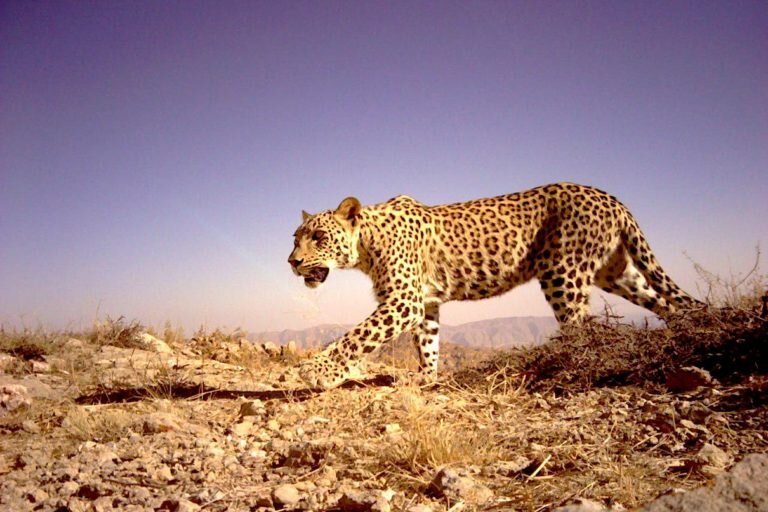UN ambassador calls for lifting sanctions to protect Persian leopards

TEHRAN – Jane Goodall, the United Nations Messenger of Peace has urged lifting sanctions on protection for the big cats, including the Persian leopard.
In an open letter on the occasion of World Environment Day 2022, he highlighted the impact of current conflicts, sanctions, and political tensions on the conservation of the Persian leopards, and on the very people dedicated to protecting them.
Goodall has called for actions to facilitate international cooperation beyond recent political circumstances, like the lifting of economic sanctions, plus the development of clear criteria regarding funding and technical cooperation.
The letter reads as follows:
At times of anguish and confusion, we turn to nature to quiet the mind and find healing. We hold on to the miraculous survival of wildlife and ecosystems, to persist in the face of struggles we have no control over, leaving us often drained and hopeless.
For us, one of those miracles is a beautiful feline, the Persian leopard (Panthera pardus tulliana), roaming the mountains, and cold winter deserts of Central Asia and the Middle East.
Persian leopard range spans 11 countries of Iran, Iraq, Turkey, Azerbaijan, Armenia, Georgia, Russia, Turkmenistan, Kazakhstan, Afghanistan, and Pakistan. Tajikistan and Uzbekistan were part of the range but they are now considered extinct there.
Almost 80 percent of these leopards are found in Iran, followed by Turkmenistan. In the Caucasus, long-term conservation efforts have led to the unique recovery of a small population in the Zangezur region, including the south of Armenia and southeast of Azerbaijan’s Nakhchivan Autonomous Republic (Persian Leopard Working Group (2022) Range-Wide Strategy for the Conservation of the Persian Leopard Panthera pardus tulliana, draft).
Almost 80 percent of Persian leopards are found in Iran, followed by Turkmenistan. During the summer of 2021, a Persian leopard was camera trapped in Tusheti Protected Areas in Georgia after a 12-year-long absence. Shortly after, Persian leopards (not related to the reintroduction program in the Russian Caucasus) were spotted in Russian Kabardino-Balkaria, Chechnya, and Dagestan.
In Kazakhstan, Persian leopards were re-discovered in 2018, though unfortunately, the only animal known there died in 2021.
Recently in Turkey, leopards were recorded at four different locations, some of which are dispersing male individuals from the source populations in the Lesser Caucasus. In Iraq, since its recovery in 2011, around nine dispersing males and a female have been identified in the Kurdistan region, at eight different locations. At least three leopards have been killed in the region in the last five years.
Persian leopard research and activities have ignited awareness and advocacy for these cats and the classic threats they face (poaching, loss of habitat and prey, human-wildlife conflict) but also raised awareness in the countries they inhabit and the importance of maintaining connectivity among them, and not just in the ecological sense. Some of the Persian leopard range countries face different political challenges.
In the Caucasus, between Azerbaijan and Armenia, leopards navigate a landscape of mines and tensions brought by the still ongoing Nagorno-Karabakh conflict. Military operations along the Iraq-Iran and Iraq-Turkey borders continue to displace people and burn Iraq’s few surviving natural forests.
Since the advent of ISIS in 2014, political tensions and economic recession have pushed biodiversity and species conservation to the bottom of the priority list in the country, with no local funding available to support local conservation projects.
Changes in U.S. leadership in 2016 resulted in the U.S. exit from the Joint Comprehensive Plan of Action (“the Iran nuclear deal”) and “maximum” pressure sanctions, not only hurting the people of Iran, but also indirectly hurting conservation initiatives, and some of the very people leading them.
The Convention on Migratory Species (CMS) and the German Federal Agency for Nature Conservation (BfN) plan to organize a Range States Meeting to adopt a Regional Strategy for the Conservation of the Persian Leopard, in the framework of the Central Asian Mammals Initiative Program of Work.
Over the past year, a group of experts from across the leopard’s range led by the IUCN Special Survival Commission Cat Specialist Group co-chairs worked to develop the foundations for it. The meeting is scheduled to take place in September 2022 in Tbilisi, Georgia.
The draft strategy is very ambitious, and the success of its implementation rests very much on the recognition that nature and conservation require international cooperation and funding, as well as keeping our community of conservationists safe to do the work it takes to protect the Persian leopard.
Camera traps are also essential for monitoring wildlife: they may not have been well understood five years ago, but they have since been demonstrated to be a fantastic way of learning about elusive animals, and much research could not be possible without them.
FB/MG
Leave a Comment